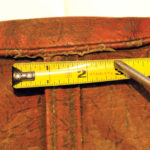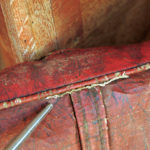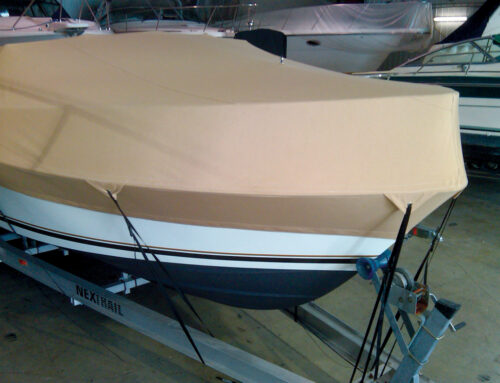Cash in on classic boat upholstery
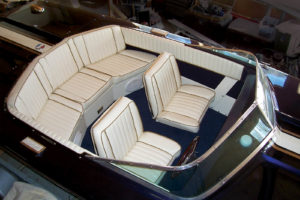
The Forestport Boat Co. restored this 1969 XK 19 Chris Craft with its Admiralty series restoration package, which includes restoring the console and gold piping on the upholstery, along with several other details.
Restoring the interior of a classic boat begins by knowing when “nearly perfect” is just fine and when it is a dismal failure. Knowing the difference and educating your customers is the first order of business in any upholstery restoration project.
“Our members who are interested in showing their boat—even winning a ‘best of’ category or ‘best of show’ award from the most prestigious shows in the country, such as the Lake Tahoe Concours d’Elegance—will approach every single detail of their boats restoration with absolute accuracy,” says Bill Basler, executive director of the Chris Craft Antique Boat Club. This includes doing the proper research, collecting evidence and finding craftsmen who can produce the expected result. In short, the restoration needs to be dead-on, original to its showroom debut, and perfect in every way.
However, Basler cautions that it isn’t as black and white as all that. “Even within the show enthusiasts, there are varying degrees of seriousness. A boat that is bound for Lake Tahoe will have every single detail scrutinized by very knowledgeable judges. At many other shows in the world, close is good enough. The owner who is creating a boat for show is motivated differently than a member who has obtained a good solid boat that he or she seeks to improve, but then use on a weekly basis.”
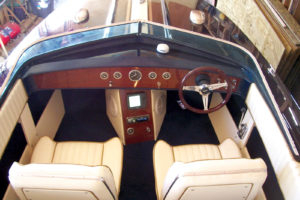
One of the boats that the Forestport Boat Co. specializes in restoring is the 1969 XK 19 Chris Craft.
Some boat owners may care about originality, but upon further questioning you may find that he or she actually favors an “original looking” interior versus one that is a museum-quality restoration. “For example, a customer may opt for vinyl rather than leather. Or opt for foam-filled cushions rather than kapok. These things may be wrong from a purist perspective, but right from a user perspective,” explains Basler.
Joan Snead, vice president of boat restoration shop Forestport Boat Co., and who also does classic boat upholstery in-house, agrees. “It is all customer preference. We allow the customer to have their choice. If they want historical accuracy, they’ll go with the original colors. If not, they choose whatever they like. If the boat is being restored for their own personal use, any color will do.”
Unfortunately, you can only buy what is available on today’s market. The primary choices come down to vinyl or leather materials that are suitable for marine and outdoor use, are resistant to ultra-violet rays, and are fade resistant and mildew resistant. A quality marine fabric will also be low-maintenance, requiring just a bit of soap and water to make it look like new again.
One point that separates the purists from the recreational boaters is the seat stuffing. Back in the 1920s, ’30s and ’40s, a natural material called kapok was used to stuff seats. The material is water resistant and buoyant, so it was the perfect stuffing choice for bottom seat cushions in vintage boats where seats doubled as life preservers. Kapok was also used to fill the U.S. Navy’s life preservers in World War II, until synthetics were introduced to the marketplace.
Today, kapok is experiencing a resurgence because it is a sustainablefiber with wonderful properties and is environmentally friendly.
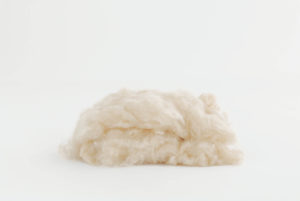
Kapok is a quality sustainable stuffing and filler that was once used in boat seat cushions and life preservers. It is rarely used in marine applications today – unless the boat being restored must be “original” in every way.
“Kapok is a quality sustainable stuffing or filler. It is eight times lighter than cotton and has a soft hand, like down,” says Mark Ekus, president of Wholesalekapok.com. “It is sometimes calledvegetal cashmere that comes from the seed pod of the kapok tree, typically grown in the South Pacific.”
However, only people who show their boats in the most prestigious competitions use kapok for marine applications, according to Ekus, who acknowledges that he doesn’t have any marine customers in the U.S. who buy kapok for boat restoration. “I do know that in Europe they use kapok quite frequently for marine upholstery,” Ekus adds.
In the U.S., the preferred choice is foam because it maintains its shape over time and delivers a tighter, tailored look. “In a Concours restoration, a restoration must be ‘as delivered,’” notes Basler. “If the original boat had kapok-filled seat cushions, then the restored boat must as well. Any deviation from this would mean a deduction of points off of the boat’s score.” The fact that you can only purchase what is available in today’s market poses a challenge for some restorers and an opportunity for adventurous entrepreneurs. “There is significant opportunity for a company willing to step up and reproduce these vintage colors and vinyl patterns,” says Basler. “Many of the original colors have been faithfully replicated in leather. Vinyl has been more of a challenge in post World War II restorations. The Chris Crafts of the late ’40s, ’50s and ’60s utilized some very adventurous colors and patterns, including Black Alligator, basket weave patterns, metallic golds and silvers. These were all very common in the period but are becoming very hard to source today.”
Bidding a classic interior restoration
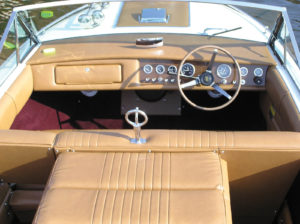
The owner of this 1985 Century Resorter had the Foresport Boat Co. completely restore the boat with his choice of interior and exterior colors.
The Forestport Boat Co. bases its estimates on time and materials. “It is very hard to bid an upholstery package job because of the unknowns,” cautions Snead. “When you remove the skin from the upholstery component, sometimes the foam underneath is still good and sometimes it is not. Often times, you’ll find that a lot of the components that were made of plywood are rotten because they have been in a boat for 20 years, so you end up rebuilding the seat as well as recovering it, and that makes a big difference in both time and materials.”
Just like remodelers who don’t know what they will find behind walls in an old home, until you peel the skin off a seat you can never be sure what problems are hiding underneath. Other variables impacting the price of a restoration are the size of the boat and the intricacy of its upholstery. “Pre-war boats were simple. They were mostly varnished wood inside with very little upholstery except for the seat cushions. Today, everything is upholstery and it is hard to get out. If the dash is upholstered, you have to remove the steering wheel to get it off,” says Snead.
An accurate, show-winning boat restoration process can be all-consuming, and depending upon the boat make and model, the process may not even make economic sense, according to Basler. However, if the owner is out to win a prestigious competition, the restoration typically has little to do with budget. Other boat owners usually watch their expenses much closer. “If a boat’s current market value is $7,500 it becomes harder to justify a $2,500 upholstery job. This is a generality. There are certainly exceptions,” adds Basler.
-
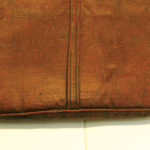
- These photos show the original uphosltery from an unrestored 1936 Gar Wood Utility. Quoting an upholstery restoration can be difficult until you know the condition of the boat underneath its old upholstery. The time and the tools involved with a restoration vary from one job to the next.
Marine upholstery—a niche market
There is really nothing different about reupholstering a boat than restoring any upholstery, says Snead. “But you wouldn’t want someone working on your boat who had only reupholstered couches,” she says. “If you took a classic boat to someone who upholstered couches, it will be damaging to the boat because it won’t have the right look or feel and it would have an interior that doesn’t go with the boat.”
Basler agrees. “For the most part, antique and classic boat interiors are very simple.” They are typically seat backs. These were often coil spring assemblies affixed to a fir backing frame. The bottom cushions were typically removable. Often they were the throwable life preservers. On many boats, the cushions were not affixed in any way—not even with snaps. Then there’s the crash padding, which was often a half-round foam pad covered with upholstery material, either vinyl or leather. Marine upholsterers good enough to win the top awards are usually sought out by boat owners, who have to wait in line to get their project on the docket.
An award-winning restoration pays attention to even the smallest details. The choice of steel or copper tacks is of utmost importance. Basler says that questions can arise over dozens of other details:
- Does the crash pad work its way around the step pads? Or does it butt into the step pads?
- What color and type of hidem?
- What color and type of thread?
- Is the kapok filled inside of muslin liners?
- Are those liners machine sewn?
- Where is the closure area that is stitched by hand?
- What color is the thread for the hand stitching?
- Did the muslin liners have markings on them? In pencil?
- Were there any other manufacturer’s tags stitched into the seams?
Beyond these issues, the tools, time-frame and techniques employed in the restoration will vary widely from one boat model to the next.
Know your boat history
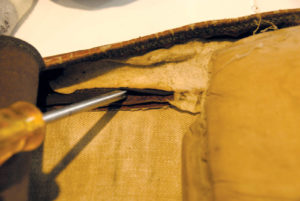
Pre-war boats featured interiors mostly of varnished wood with very little upholstery, except for the seat cushions. Today, almost everything inside a boat is upholstery and could be difficult to remove during a restoration. Variables impacting the price of a restoration include the size of the boat and the intricacy of its upholstery.
With so many variables involved, upholsterers need to know their boats. The Forestport Boat Shop has a library of books on hand so if they don’t know what a boat should look like at first glance, they know where to find the answers. “Often, older boats had some very intricate upholstery and we’ve upholstered some of the first power boats from 1905 that had buttons and all kinds of tucks,” reports Snead.
Very few customers ask for custom designs. “There is a certain amount of interpretation to make the interior user-friendly, but otherwise a 1940s boat needs to have a ’40s design, but it doesn’t mean that you can interpret what is there. You can only buy what is available, but you still don’t put a 1960s interior in a ’40s boat,” says Snead.
“I would guess that most enthusiasts side with the original upholstery colors and patterns,” notes Basler. “The variance would be this: When a boat is known to have been upholstered originally with Flame Red Tolex, one enthusiast might opt for bright red vinyl, with little regard to perfect color match, grain pattern, etc. Another enthusiast may not quit until they have found a dead-ringer for Flame Red Tolex.”Research will tell you about colors and stuffing, pleats and buttons. In addition to books on classic boats and the Internet, Basler suggests checking out historic consultants, who hire themselves out for these types of projects.
When estimating, you may want to include a travel budget in the overall cost to cover expenses for the viewing and photography of known original boats, recommends Basler. For example, all of the hull records for Chris Crafts are housed by the Mariners’ Museum in Newport News, Va. “These records are moderately accessible, and are scrutinized by researchers and hardcore enthusiasts,” he adds.
In-house or outsource
Snead operates her own in-house upholstery shop, which gives her complete control over any job and the ability to account for any unknowns that are revealed beneath the old upholstery. If the wooden seat frames are rotted out, Snead’s carpentry shop will step in and fix the problem so the upholstery can proceed without delay. Snead’s upholstery shop is headed up by one man who has been with the business for a number of years. When they need additional help, they train in-house.
The outlook
Fortunately for marine upholsterers, the business is relatively independent of the economy. “It isn’t a money-driven market because most of the people who buy classic boats have them restored. It isn’t like they are tremendously expensive,” says Snead, who adds that her business comes largely from customer referrals and the company’s web site.
Basler guesses that interest in classic boat restoration is increasing. “There is a tremendous amount of value being placed on many of these boats. Pre-World War II triple cockpit runabouts, well-restored, are selling for several hundred thousand dollars. The antique and classic boat collecting and restoration hobby is in its infancy as compared to cars. We are just getting started. The overall numbers of boats produced were much lower than autos. The rare boats exist in quantities of less than fifty. With some, there are one, two or three known to exist. This is driving the value and the collectability. This has come about very gradually over the past 20 years or so.”
Restoration, done right, can be a satisfying and lucrative business. Says Snead, “We make the boat feel and look better than originally because most were production boats. The upholstery came out in a mass production manner, so what we do is more detailed and more luxurious than the original, while keeping true to the way the boat was supposed to feel.” And that’s when “nearly perfect” is just fine.
 TEXTILES.ORG
TEXTILES.ORG 


